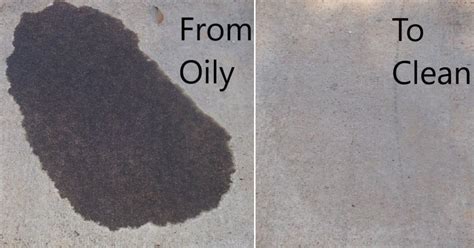How to Get Oil Out of Concrete: A Comprehensive Guide
Oil stains on concrete are unsightly and can be a real headache. Whether it's a leaky car, spilled motor oil, or cooking oil mishap, dealing with these stains requires a strategic approach. This guide provides a step-by-step process to effectively remove oil from your concrete surfaces, restoring their pristine look.
Understanding the Enemy: Types of Oil and Their Impact
Before diving into the cleaning process, it's crucial to understand the type of oil you're dealing with. Different oils have varying compositions and require slightly different treatment methods.
- Motor Oil: This is a common culprit, often leaving dark, stubborn stains. Its viscosity and chemical composition make it challenging to remove completely.
- Cooking Oil: While less viscous than motor oil, cooking oil can still leave noticeable stains, especially if left to sit for a prolonged period. Its composition is different, impacting cleaning methods.
- Other Oils: Hydraulic fluids, transmission fluid, and other lubricants present similar challenges to motor oil.
Assessing the Stain: Size and Age Matter
The size and age of the oil stain significantly impact the cleaning process. Fresh stains are considerably easier to remove than older, set-in stains.
- Fresh Stains: Act quickly! The sooner you address the spill, the better your chances of complete removal.
- Older Stains: These will require more effort and possibly stronger cleaning agents.
Essential Tools and Materials
Before you begin, gather these essential supplies:
- Absorbent Material: Cat litter, sawdust, or oil absorbent pads are ideal for soaking up excess oil.
- Detergent: A strong degreasing detergent like dish soap or a dedicated concrete cleaner.
- Water: A hose with a spray nozzle or a bucket of water.
- Stiff-Bristled Brush: For scrubbing the stained area.
- Pressure Washer (Optional): For particularly stubborn stains or large areas.
- Safety Gear: Gloves and eye protection are recommended.
Step-by-Step Guide to Oil Stain Removal
Here's a practical, step-by-step guide to effectively remove oil stains from your concrete:
1. Absorb Excess Oil
Immediately after the spill (for fresh stains), cover the affected area with an absorbent material like cat litter or sawdust. Allow it to sit for several hours or overnight to absorb as much oil as possible. Sweep or vacuum up the saturated material.
2. Degrease the Area
Mix a generous amount of degreasing detergent with warm water. Apply the solution directly to the stain, ensuring it's thoroughly saturated. Let it sit for at least 15-20 minutes to allow the detergent to break down the oil.
3. Scrub the Stain
Using a stiff-bristled brush, scrub the stained area vigorously. Work from the outside of the stain inward to prevent spreading. Rinse frequently with water.
4. Rinse Thoroughly
Once you've scrubbed the area, rinse it thoroughly with water. A pressure washer can be helpful for removing lingering residue, but use caution to avoid damaging the concrete.
5. Repeat if Necessary
For stubborn stains, you might need to repeat steps 2-4. Consider using a stronger degreaser if the initial attempt proves insufficient.
6. Drying and Prevention
Allow the concrete to dry completely. Consider using a concrete sealant afterwards to help prevent future oil stains from penetrating the surface.
Tips for Success
- Act Quickly: The faster you address an oil spill, the easier it is to clean.
- Ventilation: Work in a well-ventilated area, especially when using strong cleaning agents.
- Test in an Inconspicuous Area: Before applying any cleaning solution to the entire stain, test it on a small, hidden area of the concrete to ensure it doesn't damage the surface.
By following these steps and utilizing the right tools and materials, you can effectively remove oil stains from your concrete and restore its original beauty. Remember that patience and persistence are key, especially when dealing with older or stubborn stains.
